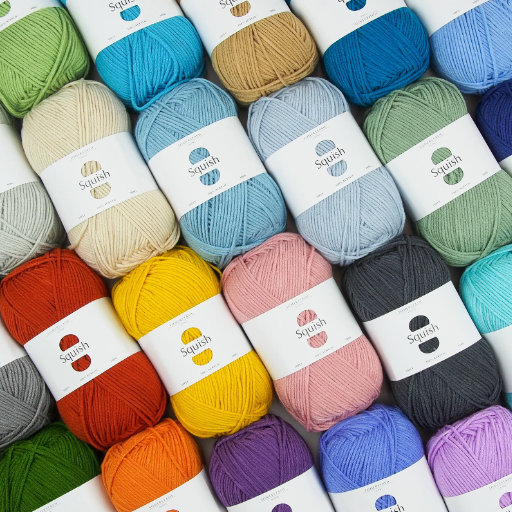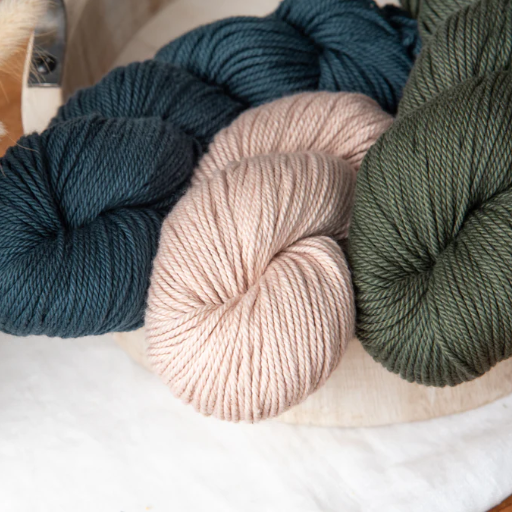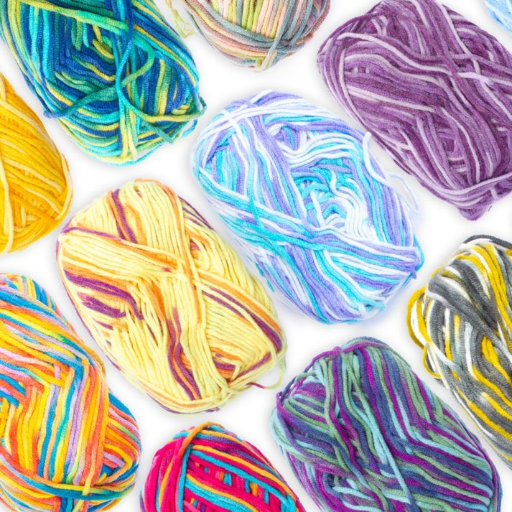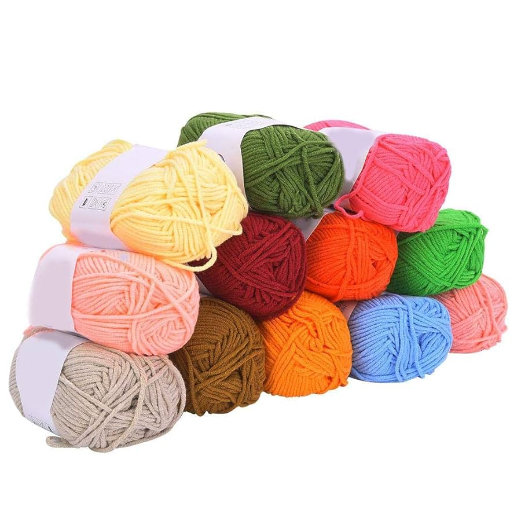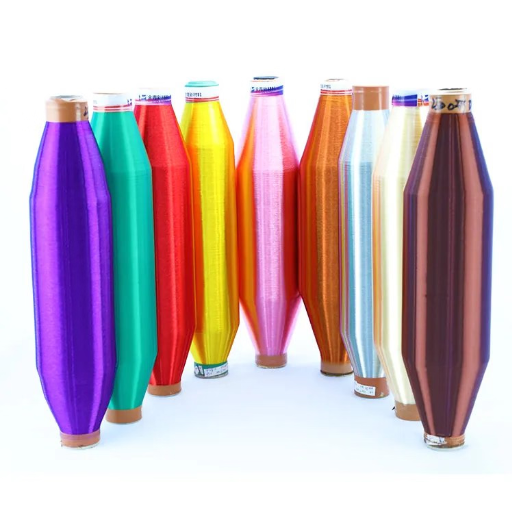Yarn has varying attributes that crocheters and knitters strive to achieve for absolutely any endeavor; they certainly would be able to tell you cotton acrylic blend is far more superior than others, given the great range of projects it can be used for, as it combines the softness and breathability of cotton with the prolonged durability and elasticity of acrylic. Providing the ideal foundation for cozy garments, durable accessories, or even intricate home-decor pieces, this cotton blend provides both beauty and functionality that is unmatched. In this article, get ready to learn about its ease of use in crafting projects with different levels of intricacy and skill, making it a valuable addition to any crafter’s tools.
What Makes Cotton Acrylic Blend Yarn So Popular?

The versatility of cotton acrylic blend yarn is unparalleled. It is a favorite in crafting because it combines the natural softness & breathability of cotton with the durability and elasticity of acrylic. The fibers supplied by hug fibers are considered ideal for all kinds of crafting activities as they are lightweight yet strong, which adds to their quality as well as resists shrinkage, fading, & pilling.. Moreover, the yarn is available in numerous colors at very reasonable prices, which enhances its appeal for crafting high-quality designs.
The Benefits of Using Acrylic Yarn
The lightweight properties, plethora of colors, and lack of fading, pilling, or wear all amplify the value of acrylic yarn for crafters. The resistance against these factors ensures durable products, making it ideal for both novice and experienced crafters alike.
Advantages of Cotton Yarn in Blends
The benefits of cotton yarn within blends are quite astonishing. Cotton moisture-wicking capabilities together with its breathability enable it to be used in apparels meant for warm or humid weather, unlike many other fibers. The durability of the blended yarn guarantees that it maintains its structural integrity even after being used and washed repeatedly. Furthermore, cotton provides a smooth texture, natural softness, and breathability which enhances the overall perception of the final product. In addition to these attributes, when used with synthetic fibers like acrylic, cotton fulfills the need for comfort and strength at an affordable price for crafters and everyday wearers.
Why Choose a Cotton Acrylic Blend?
a cotton acrylic fabric blend is especially useful as it provides both comfort and practicality. The cotton component is soft and breathable which is well-suited for warm weather or wearable projects, while the acrylic component adds stretch, durability, and ease of care. This blend is adaptable, which is why it is the preferred choice for both novice and expert crafters who need dependable fabrics that do not compromise style, quality, or craftsmanship.
How to Choose the Right Cotton Acrylic Blend Yarn for Your Project?

In the process of selecting the most suitable cotton acrylic blend yarn for a specific project, I always consider the intended purpose and functionality of the final product first. In the case of lightweight and breathable garments such as summer tops or baby clothes, I prefer long-staple cotton blended yarn because it is softer against the skin and gives comfort. However, if I am working on items which can undergo frequent use and need durable construction, like blankets or accessories, I use a blend with more acrylic since it makes the piece easier to wash and adds durability. Besides those, I also consider the yarn weight and gauge to check if they align with my pattern requirements. Every so often, I do a small swatch test to see how it works up. This approach ensures that I choose blends that perform beautifully for their intended purpose.
Understanding Yarn Weight and Its Importance
The thickness of yarn is referred to as “yarn weight” and this impacts the drape, texture, and appearance of the finished piece. Selecting the appropriate yarn weight is critical for fulfilling the requirements of the pattern while achieving the desired results. The different weights, ranging from lace to bulky, each have distinct characteristics suitable for particular projects such as shawls or cozy blankets. From lace to bulky, each provides unique traits tailored for specific projects—like airy shawls for lighter yarns or cozy blankets for heavier ones. The combination of yarn weight, gauge, and match separates functional and visually stunning pieces harmoniously together.
Factors to Consider for Knitting Yarn
When choosing knitting yarn, focus primarily on fiber content, yarn weight, and gauge compatibility. Fiber content impacts texture, strength, and warmth, while yarn weight affects the overall structure of the project and its appropriateness to specific patterns. Always check yarn gauge requirements as indicated in the pattern to accomplish the desired dimensions and finish. Furthermore, balance the care requirements of the yarn and the proposed use of the project so the chosen blend meets the degree of aesthetic, comfort, and practicality required.
Selecting a Crochet Yarn That Fits Your Needs
When I choose a crochet yarn, I start by evaluating the project’s goals and how it will be used. For example, with winter scarves, I prefer using wool or wool blends because they are warm and elastic. For summer projects, I tend to use cotton because of its lightness and breathability. It is also important for me to match the yarn weight to the intended project: chunky weight is good for adding bold structure, while intricate, delicate work is best with fingering weight. Checking the care instructions is also important; for items receiving heavy use, easy care yarns are essential. After all is said, done, and checked, I just need to trust the vision I had in my head and see if the yarn, in terms of touch and look, aligns with the planned tapestry.
What Are the Best Uses for Cotton Blend Yarn?

I make the best choice from the many crochet projects to cotton blend yarn after taking into account the specific characteristics of the yarn. A cotton blend includes the softness and breathability of cotton together with an acrylic, bamboo, or even wool, making it strong and elastic. The combination of these qualities gives the blends great versatility that makes them suitable for various projects. Below is a summary of the crochet projects I consider best suited for cotton blend yarn.
- Lightweight Garments
Summer tops, cardigans, and light shawls can be created with the breathable cotton blend yarns. The cotton fiber blended into the garment keeps it cool while the other blended fibers retain its shape, durability and make the fabric more sturdy. I personally enjoy working on airy patterns and designs that complement warm weather apparel.
- Baby Items
Low maintenance baby blankets, booties, or hats are crafted with cotton blends. Cotton is incredibly soft and gentle against sensitive skin, which makes it very comfortable, while the other blended fibers adds some strength to these pieces to maintain fabrics shape even after multiple washes, which is critical for baby projects.
- Home Décor
Dishcloths, coasters, and pot holders are made with cotton blend yarns, but the most cotton blend intensive piece where it shines is the coasters. Functional pieces benefit from cotton’s absorbency and heat resistance, while blended fibers improve durability. Plus, bold colors or fun textured patterns can be employed to liven up any space.
- Accessories
For market bags, headbands, or casual hats, cotton blend works the best. Its lightweight nature is a plus for items like these that require structure without being overly heavy. My favorite, and a lesser-known use of this cotton blend, is for making reusable bags: sturdy enough for carrying groceries, but soft to the touch.
- Amigurumi
For enthusiasts who crochet dolls and figurines, a cotton blend yarn provides the best combination of softness and strength. That accentuates tight stitches which provide structural integrity, as well as ensure comfort when holding or cuddling with the finished piece.
In selecting a cotton blend yarn for a project, I consider the yarn’s weight, drape, and stitch definition. Blends offer great customization for the specific needs of a project, and their versatility guarantees there is always something different to attempt!
Creating Soft Yarn Garments
When constructing soft yarn clothing, a paramount consideration is the blend selection alongside the stitch techniques. Cotton blended with a hint of bamboo or silk is great because of its breathability and softness for use in cardigans, sweaters, or scarves. For luxury versatility, lighter like DK or sport weight cottons should be selected as they have a soft texture and drape beautifully. In addition, smoother stitches like half-double crochet or basic knit patterns are optimal in enhancing the comfort of the final piece. Remember to always block your garments after finishing to bring out the softness and ensure the desired shape.
Utilizing Yarn for Crocheting and Knitting in Home Decor
In home decor, yarn can be used to create both decorative and functional items. I enjoy working with cotton blends because I can create pillow covers, throws, intricately patterned wall hangings, and other decorative items that are pleasant to behold but also durable. Softness is important, but so is longevity; these items should be able to weather everyday use without falling apart. For larger projects like rugs and storage baskets, I use chunkier yarns for their bold visual impact, as well as their strength. It’s all about getting the right design balance, something with enough “petiteness” yet sturdiness to get the job done. Every stitch adds character, charm, and touches that give the decor an inviting warmth—something that is truly unique and shows personality, unlike anything purchased in stores.
How to Maintain and Care for Cotton Acrylic Blend Yarn Creations?

All cotton-acrylic projects need gentle but practical care. Handwash or machine wash on a delicate cycle to avoid stretching or color fading. Use fabric softeners, avoid bleach or strong detergents, and gentle supports are acceptable. After washing, reshape the piece and lay it flat to dry to maintain its integrity. The item is not held by hooks or wrung to prevent gradual weakening of fibers. Correct folding, aided by cool and dry storage, preserves the handcrafted beauty.
Tips for Washing Machine Washable Yarn
In regard to storing my yarn creations, I would like to maintain their protection as well as their good condition for long periods of time. I first make sure that I clean every single item thoroughly and dry it before placing it in storage because dirt residue and moisture can cause degradation over time. Rather than hanging them, I prefer folding them so that they do not get stretched out, which can alter their shape. I prefer utilizing breathable storage containers or cotton bags that protect from dust as well as insects while providing ventilation. I often use cedar blocks or lavender sachets to repel moths and for added security. These practices are preemptive and simple, which help hand-made pieces last for long years, ensuring they stay preserved in a usable state for four years.
Storing Your Yarn Creations Safely
In terms of laundry-machine washable yarn, my focus is always on simplicity and care. Select the gentle cycle, if possible, wash with cold water, as this minimizes the likelihood of shrinkage or damage to the fibers. Use a detergent that is not strong and formulated for delicate fabrics because even durable yarns will degrade over time due to harsh chemicals. It is best to give your creations added protection by placing them in a mesh laundry bag which helps reduce friction during the wash. After washing, I recommend tumble drying on low heat or laying the item flat to air dry, especially if there are specific patterns or designs you wish to retain. These steps, though small, help ensure longevity and vibrancy in your yarn creations.
Common Mistakes to Avoid When Caring for Cotton Acrylic Items
Preserving cotton-acrylic items requires avoiding common mistakes. First, never wash in hot water, as this leads to fiber weakening or shrinkage. Opt for cold or lukewarm settings instead. Even though weak detergents are preferred, do not use harsh ones or fabric softeners. Sugary detergents will break down the material or create pilling, which refers to those little balls you see on clothes. Failure to rinse properly is another common mistake, laundry detergent residue will stiffen the fabric. Pilling will form if the appropriate rinsing is skipped. Furthermore, refrain from wringing the items to dry, as this will distort their shape. Gently squeeze out excess water and lay them flat to dry. Skipping washing can mildew… My dear, ensure the items are clean and completely dry, before the breath of air is stored within the containers. Last, pieces being stored in damp or poorly ventilated spaces encourages mold and odor. Wrapping characters will need to be washed often and emerge from the water needing washing with air.
Is Yarn for Beginners Suitable in Cotton Acrylic Blends?

In terms of laundry-machine washable yarn, my focus is always on simplicity and care. Select the gentle cycle, if possible, wash with cold water, as this minimizes the likelihood of shrinkage or damage to the fibers. Use a detergent that is not strong and formulated for delicate fabrics because even durable yarns will degrade over time due to harsh chemicals. It is best to give your creations added protection by placing them in a mesh laundry bag which helps reduce friction during the wash. After washing, I recommend tumble drying on low heat or laying the item flat to air dry, especially if there are specific patterns or designs you wish to retain. These steps, though small, help ensure longevity and vibrancy in your yarn creations.
Getting Started with Soft Cotton Yarn for Crochet
soft cotton yarn is the most rewarding material to work with for crocheting projects. This is due to cotton’s breathability, durability, and stretch. Ranging from lightweight clothing to functional home décor, it can truly do it all. With this, I recommend a high-quality cotton yarn with a smooth texture and a weight of number 3 or 4 for easier handling. To achieve clean and even stitches, pair it with a crochet hook that fits the yarn. This ensures ease during stitching and creates effortless movement. From my experience, simple patterns like granny squares or dishcloths are perfect to get accustomed to working with cotton. I guarantee that your creative potential will grow immensely once you realize just how versatile this material is.
Reference
- Fabric Trace: Cotton Acrylic Blends Advantages and Properties – Discusses the benefits of cotton-acrylic blends, including breathability, durability, and affordability.
- Knitting Paradise: Cotton vs Cotton/Acrylic – Highlights why cotton/acrylic blends are ideal for knitting, focusing on shape retention and washing ease.
- Quora: Pros and Cons of Acrylic Yarn vs Natural Fibers – Explores the properties of cotton and acrylic yarns, including their environmental benefits and comfort.
Frequently Asked Questions (FAQs)
Q: What is cotton acrylic blend yarn, and why is it popular for crochet and knitting projects?
A: Cotton acrylic blend yarn is a mixture of natural cotton fibers and synthetic acrylic fibers. This blend offers the softness and breathability of cotton along with the durability and elasticity of acrylic, making it a popular choice for a variety of crochet and knitting projects. The yarn is soft and versatile, suitable for creating garments, accessories, and home decor items.
Q: How does worsted weight yarn compare to other yarn weights for knitting and crochet?
A: Worsted weight yarn is a medium-weight yarn that is thicker than sport weight and finer than bulky yarn. It is a versatile choice for both knit and crochet projects, providing a good balance of stitch definition and ease of handling. Worsted weight is ideal for sweaters, blankets, and other projects where warmth and structure are desired.
Q: Is cotton acrylic blend yarn suitable for baby yarn projects?
A: Yes, cotton acrylic blend yarn is an excellent choice for baby yarn projects. It offers the softness and comfort needed for baby garments and blankets, while the acrylic component adds durability and easy maintenance, making it suitable for frequent washing.
Q: What are the benefits of using sport weight yarn for knitting and crochet?
A: Sport weight yarn is lighter than worsted weight yarn, making it ideal for creating lightweight garments and accessories. It provides excellent drape and flexibility, perfect for projects like shawls, baby clothes, and summer tops. The lighter weight allows for more intricate stitch patterns and a softer feel of cotton.
Q: How does mercerized cotton affect the feel of cotton yarn in crochet and knitting?
A: Mercerized cotton undergoes a special treatment that enhances its sheen, strength, and color absorption. This process gives the yarn a smooth, lustrous finish, making it ideal for projects where a polished look is desired. Mercerized cotton is particularly popular for summer garments, amigurumi, and home decor items.
Q: What makes acrylic and cotton yarn blends a good alternative to 100% wool yarn?
A: Acrylic and cotton yarn blends offer a lightweight and breathable alternative to 100% wool yarn. They are less likely to cause allergies, are easier to care for, and provide a similar warmth and comfort. These blends are also more affordable, making them a popular choice for everyday projects and those with wool sensitivities.
Q: Can you explain the differences between 3 DK weight yarn and other weight yarns?
A: 3 DK weight yarn, also known as double knitting yarn, is slightly heavier than sport weight yarn but lighter than worsted weight yarn. It is a versatile choice that works well for a wide range of projects, including garments, accessories, and toys. The DK weight provides a good balance of thickness and drape, making it a favorite among knitters and crocheters.
Q: Why is multicolor yarn popular for crochet knitting projects?
A: Multicolor yarn is popular for crochet knitting projects because it adds visual interest and depth without requiring complex colorwork techniques. The yarn is dyed in multiple colors, allowing for beautiful gradients and patterns to emerge naturally as you work. This makes it a great option for creating vibrant accessories and garments that stand out.
Q: How does the blend of acrylic and cotton in yarn affect its use in knitting and crochet projects?
A: The blend of acrylic and cotton in yarn combines the best qualities of both fibers. Acrylic adds durability and elasticity, while cotton contributes softness and breathability. This makes the blend ideal for projects that require a balance of comfort and resilience, such as everyday wearables and home textiles. The acrylic and cotton blend is also easy to care for, as it is machine washable and retains its shape well.
Q: What are the unique characteristics of alize cotton gold yarn?
A: Alize cotton gold yarn is a popular choice for its high quality and unique blend of cotton and acrylic fibers. This yarn offers a smooth texture, vibrant colors, and a soft touch, making it perfect for a variety of projects, from garments to accessories. It is known for its durability and ease of use, providing consistent results for both beginners and experienced crafters.








